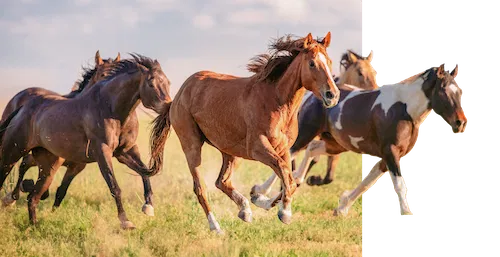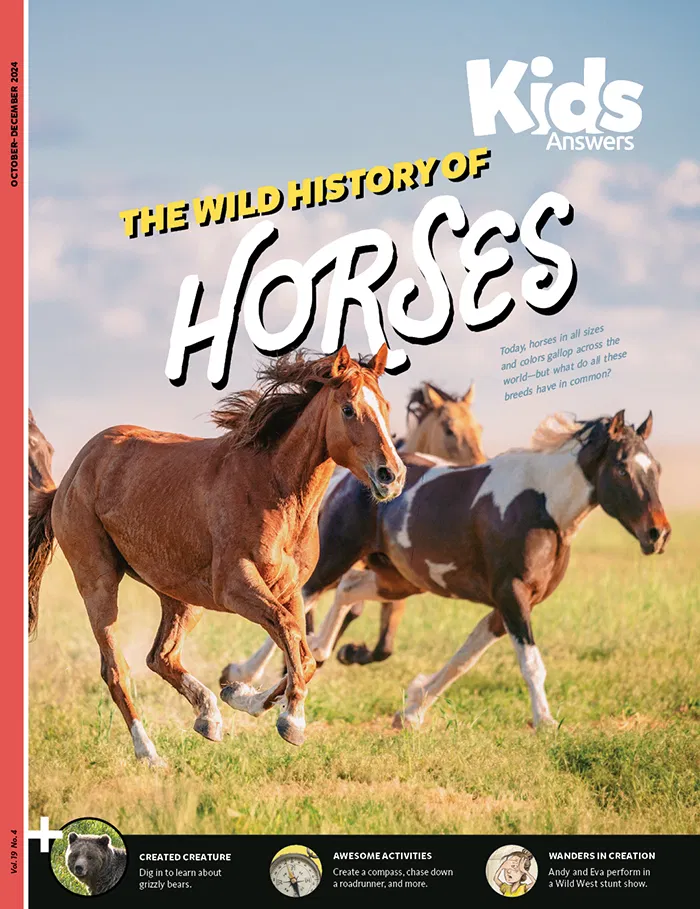The Wild History of Horses
The dog may be “man’s best friend,” but the horse has been a helpful companion to humans throughout history! And when you consider the close bond between a horse and rider, it’s hard to think of a more dynamic duo than the cowboy—or cowgirl—and a trusty steed.
The hardworking horses of the Wild West played an important part in American history. Cowboys rode horses to travel and herd cattle. Native American tribes relied on horses for hunting, traveling, and riding into war. Farmers used horses to plow fields and grow food. Pony express riders delivered mail on horseback. Even preachers traveled by horseback to spread the gospel from town to town.
God designed the horse kind to help humans in all kinds of ways—and not just in the Wild West. Every breed of horse has something unique to offer. Today, hundreds of breeds come in all sizes and colors—and they all started with the two horses that trotted off Noah’s ark.
A Wild Ride
God created the original horse, or equine (EE-kwine), kind on day six of creation week, around 6,000 years ago. (If two animals look similar and can have babies together, they are the same created kind.) He built incredible genetic variety into the horse kind. This means that God designed the horse kind with the ability to adapt, or change, allowing them to thrive in different environments by displaying certain traits.
All wild and domesticated horses belong to the same species (Equus ferus). (The term species is used to put animals in categories to help scientists study them better.)
Breeds are specific groups of animals from a species that have been bred by humans for particular traits or abilities.
When Noah built the ark (Genesis 6), he took aboard two members of the equine kind. These ancestors led to the zebras, donkeys, and horses we have today. After the flood, members of the horse kind spread and multiplied throughout the world. As they adapted to different environments, new varieties appeared.
A Coat of Many Colors
Horses come in a variety of beautiful colors and patterns. Here are some of the most common.

A Different Breed
The hundreds of horse breeds fit into five broad categories. Each category has something special and unique to offer.
- Ponies are short horse breeds. Ponies were bred for similar reasons as horses, including riding, pulling, and hauling.
- Draft horses have been bred for their size and strength to pull heavy loads.
- Light horses are small, but not as small as ponies. Some have been bred for speed and herding.
- Warmbloods are athletic. They are sometimes called sporting horses.
- Gaited horses were bred to move gracefully. With their endurance, they can travel long distances, making them valuable for riding.
A Horse Is a Horse, of Course!
Natural selection is a process through which creatures with specific characteristics survive better than others in an environment. For example, animals with long hair stay warmer and survive better in colder climates than animals with short hair.
Horses adapt to different environments easily. American feral horses (often referred to as mustangs) developed harder hooves compared to domesticated horse breeds, allowing them to travel across rocky or uneven terrain. Also, Yakutian (ya-KOO-tee-an) horses have adapted to live in the frigid land of Siberia. These horses have thick coats and short, stocky bodies to conserve heat. When temperatures get very cold, they may go into a state of torpor (like hibernation but without the sleep). They adjust their metabolism, lower their body temperature, and slow their heartrate.
Many people believe that some animals have evolved, or changed, into other kinds of animals. For example, they believe that dinosaurs evolved into birds. But we know from God’s Word that he created different animal kinds separately during creation week. Yes, horses breed other horses, but they don’t turn into new kinds of animals.
Evolution means that creatures gain genetic information as they evolve into new kinds of animals. In natural selection, rather than gaining new information, the information an animal already has just changes around or sometimes gets lost. Either way, an animal always stays in the same animal kind. Big, small, spotted, or striped—horses are still horses!
Natural selection doesn’t prove that animals evolved from one kind of animal to a different kind of animal. It confirms the Bible and shows that our Creator brilliantly designed his creatures with the ability to adapt.
4 Jobs of Wonderful Workhorses

1. Warfare
Horses have carried soldiers into battle for thousands of years, from Pharoah’s army and Japanese samurai to medieval knights and American Civil War soldiers.

2. Work
People have long used horses to do important jobs such as transporting goods, plowing fields, herding cattle, mining coal, and so much more.

3. Travel
Horses have provided transportation for humans by carrying us on their backs and pulling chariots, wagons, streetcars, carriages, and more.

4. Sports
People have invented all sorts of sports based on horses’ athletic abilities, including jumping and racing.
Stewarding the Steed
Humans have played the biggest part in producing the hundreds of horse breeds we have today. Throughout history, people have bred horses for certain traits in a process called artificial selection. Artificial selection has given us over 350 unique breeds of horses!
Breeding for certain traits allows different horse breeds to do particular jobs. Horses of the American West were bred to be smart and agile for ranching and herding animals. Thoroughbred horses (often used as racehorses) are bred to have slender legs for speed. Draft horses have been bred for size and strength to carry heavy loads.
In Genesis, God gave humans authority over the earth. With that authority comes a responsibility to wisely care for, or steward, creation. Breeding animals to have special traits or to do certain jobs is one way to steward creation well.
Wild and Wonderful
It’s been a wild ride for humans and horses from creation to today. For thousands of years, horses have been bred to help us do all kinds of jobs. Not only that, but they have inspired us with their beauty, strength, and speed.
We can show our thanks to the Creator for providing the horse kind by wisely stewarding all his wild and wonderful creatures with kindness and care.
Hand Measurement
A hand is a unit used to measure horses and ponies. Each hand is four inches. A horse’s height is measured at its shoulders. How many hands do you stand?

Lasso Some Fun
Trot on over to the Kids Answers blog to discover animal facts, learn about the Bible, and lots more.
Kids Answers Magazine
The Wild History of Horses
Today, horses in all sizes and colors gallop across the world—but what do all these breeds have in common?
Browse Kids Issue- © 2025 Answers in Genesis
- Privacy Policy
- Contact
- About

